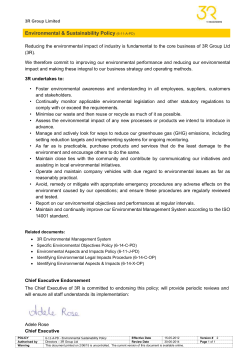
State Water Project/Climate Action Plan Overview
California Municipal Utilities Association April 15, 2015 Carlsbad, California John T. Andrew Assistant Deputy Director Department of Water Resources State Water Project – Overview & Statistics • SWP is 4% of CAISO load, and 3% of all load in CA (about same amount as San Jose or San Francisco) • SWP pumping capacity is 2,600 MW, consumes 6 to 9.6 Million MWh to move 2 to 4 Million acre-ft of water per year • SWP is the third largest generator of clean hydropower in CA • SWP generation capacity is 1,700 MW, generates 4 million to 7 million MWh • SWP produces about 14% of California’s hydropower One Edmonston pump uses 60 MW Plant Capacity ~ 840 MW 3 Climate Action Plan Phase 1: GHG Emissions Reduction Plan (GGERP) Near‐Term (2020) Goal: Reduce GHG emissions to 50% below 1990 levels by 2020 Long‐Term (2050) Goal: Reduce GHG emissions to 80% below 1990 levels by 2050 SWP’s Portfolio Evolution to Meet 2050 GHG Target Combined Cycle Gas, 12% Clean Hydro, 50% 88% emissionsfree resources Existing Contracts and Market Purchases, 30% Combined Cycle Gas, 12% 2050 Renewable Resources, 8% 2020 Clean Hydro, 50% 58% emissionsfree resources Renewable Resources, 38% 5 Water and Energy Connection Energy Intensity North Coast Region Energy Intensity South Coast Region “Everyone is entitled to his own opinion, but not to his own facts.” ‐‐Daniel Patrick Moynihan California Water Plan Update 2013 “Politicians discussing global warming” Isaac Cordal John T. Andrew, P.E. Assistant Deputy Director Department of Water Resources (916) 651-9657 jandrew@water.ca.gov 155 SWP’s Primary Water Delivery Facilities • The SWP is the largest state-owned and operated water system in the country • SWP deliveries provide water to nearly 25 million Californians and about 750,000 acres of irrigated farmland • DWR also operates the SWP to improve water quality in the Delta, control Feather River floodwater, provide recreation, and enhance fish and wildlife habitat. 13 Changing Trends of Rain vs. Snow Changing Runoff Trends
© Copyright 2025



![GERMAN ASSOCIATION FOR SOCIAL SCIENCE RESEARCH ON JAPAN [VSJF]](http://cdn1.abcdocz.com/store/data/000367445_1-c3b9b7e29ce6d2e4aa00e3677ce88284-250x500.png)








